In this article, you can read about the Ocean Resources: Biotic And Abiotic (marine mineral resources) that the structure of the Earth is composed of – for UPSC Geography.
Ocean Resources
The Ocean is one of Earth’s most valuable natural resources. It provides food in the form of fish and shellfish—about 200 billion pounds are caught each year.
Ocean resources provide jobs, goods, and services for billions of people around the world and have immense economic importance. Their resources include food, fuel, renewable energy, minerals, sand and gravel, and tourism.
It is mined for minerals (salt, sand, gravel, and some manganese, copper, nickel, iron, and cobalt can be found in the deep sea) and drilled for crude oil.
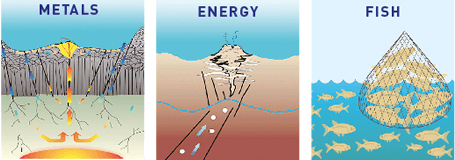
The ocean plays a critical role in removing carbon from the atmosphere and providing oxygen. It regulates Earth’s climate.
Typically Ocean Resources can be classified in to two broad categories –
- Biotic Resources
- Planktons
- Nektons
- Benthos
- Abiotic Resources
- Mineral
- Energy
Biotic Resources
- Biotic means alive and Abiotic means nonliving.
- Biotic resources of the seas include fishes, crustaceans, molluscs, corals, reptiles and mammals etc.

Planktons
Plankton are the diverse collection of organisms found in water that are unable to propel themselves against a current.
- Phytoplanktons– floating and drifting micro plants.
- Autotrophs
- Eg- algae and diatoms
- Zooplanktons– floating and drifting micro animals.
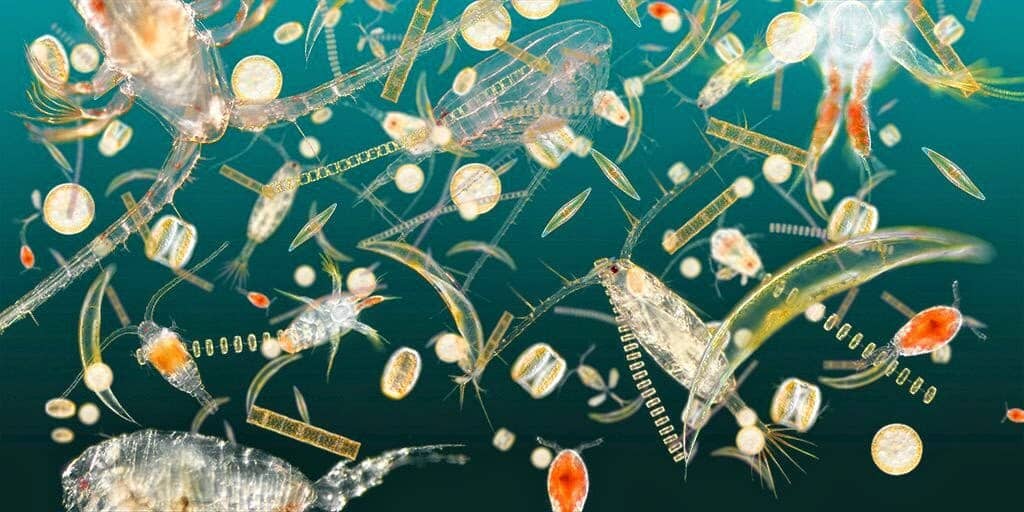
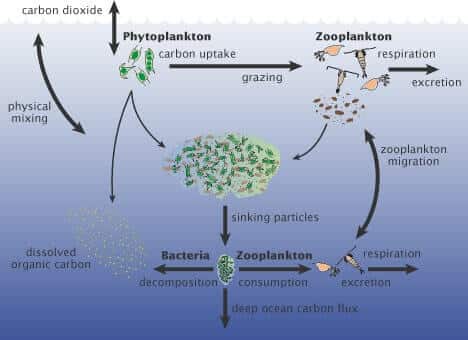
Nektons
Nekton (or swimmers) are living organisms that are able to swim and move independently of currents at various depths of seas and oceans.
Nektons –
- fishes
- pelagic
- demersal
- mammals
- dolphin
- Blue
- whale
Fishes
- Pelagic fish live in the pelagic zone of ocean or lake waters – being neither close to the bottom nor near the shore
- Demersal fish that live on or near the bottom.
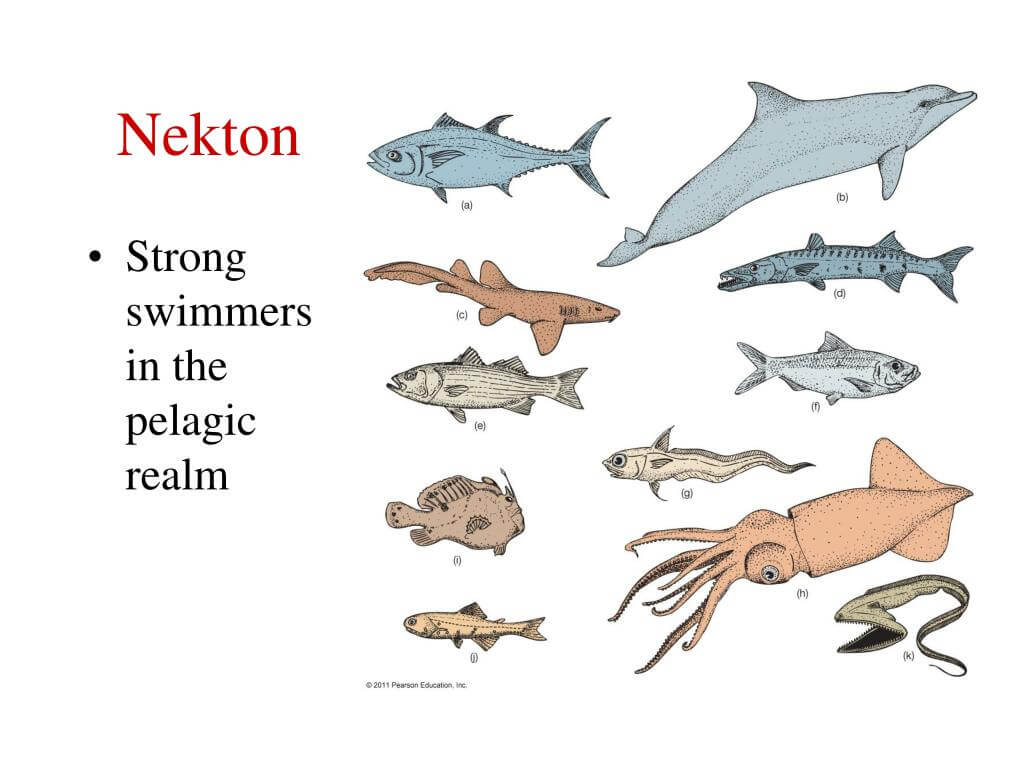

Benthos
Benthos is the community of organisms that live on, in, or near the seabed, also known as the benthic zone. This community lives in from tidal pools along the foreshore, out to the continental shelf, and
then down to the abyssal depths.
Benthos –
- mobile
- immobile
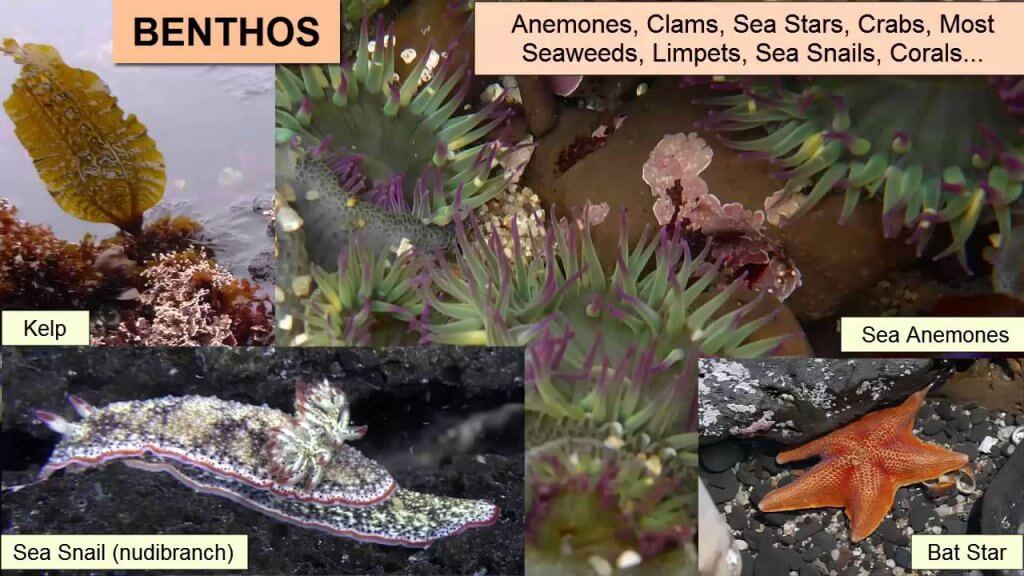
Mineral Reserves
- Mineral dissolved in seawater
- Continental Shelf and Slope Deposits
- Deep ocean bottom deposits
1. Mineral dissolved in sea-water
- Salt
- Bromine
- Magnesium
- Gold
- Zinc
- Uranium
- Thorium
2. Continental Shelf and Slope Deposits
- Sulfur – associated with marine volcanism.
- Ex. Gulf of Mexico – a rich source of sulfur
Magnetite reserves are found along the circum pacific volcanic belt.
- monazite sand (source of thorium) at Kerala coast
- Gold (Alaska)
- Zircon (Brazil, Australia)
- Diamond (SouthAfrica)
- Calcium-– Peruvian coast rich deposits of calcium and phosphate
- Sand and gravel – significant building materials widely found on beds of continental shelves
- Fishes are rich in nitrate and phosphate, high protein, medicinal use
- Pearls
3. Deep ocean bottom deposits
- Manganese nodules– It comprises several minerals like nickel, copper, cobalt, lead, zinc, etc.
- The maximum percentage of Iron and Manganese.
- Cobalt-rich marine deposits associated with seamounts and guyots.
- Phosphate-in form of phosphoritic modules on shallow seabeds.
- Polymetallic nodules
- Polymetallic nodules are rounded accretions of manganese and iron hydroxides that cover vast areas of the seafloor but are most abundant on abyssal plains.
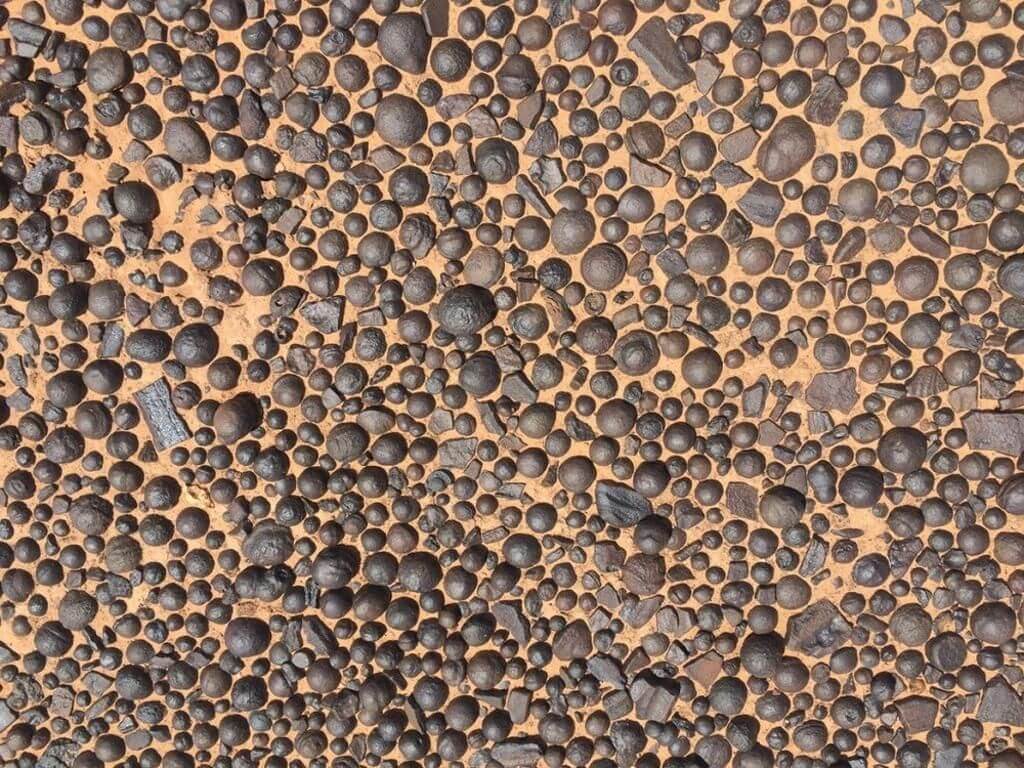

Energy reserves
- Renewable
- OTEC
- Wave
- Tidal
- Wind
- Non-Renewable
- Gas hydrates
- Mineral oil
- Natural gas
Ocean thermal energy conversion (OTEC) –
- Ocean thermal energy conversion (OTEC) uses the temperature difference between a cooler deep and warmer shallow or surface seawaters to run a heat engine and produce useful work, usually in the form of electricity.
- However, since the temperature differential is small, the thermal efficiency is low, making its economic feasibility a challenge.
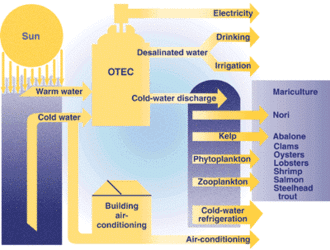
Wave Energy –
- Wave energy is produced when electricity generators are placed on the surface of the ocean. The energy provided is most often used in desalination plants, power plants, and water pumps. Energy output is determined by wave height, wave speed, wavelength, and water density.
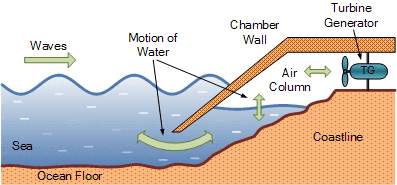
Tidal energy –
- Tidal energy is produced through the use of tidal energy generators.
- Large underwater turbines are placed in areas with high tidal movements and are designed to capture the kinetic motion of ocean tides in order to produce electricity.
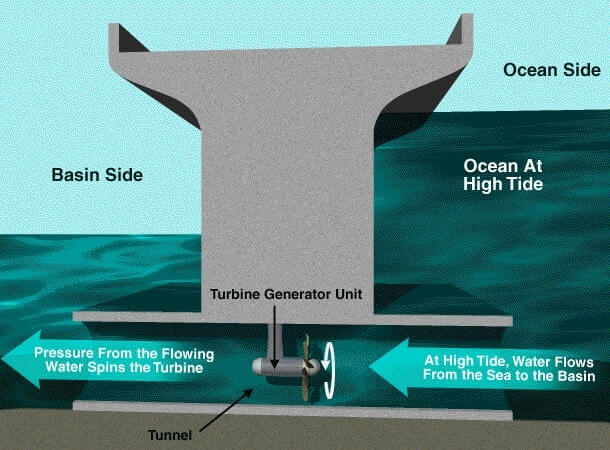
Offshore Wind energy –
- Offshore wind power or offshore wind energy refers to the construction of wind farms in bodies of water to generate electricity from wind. Stronger wind speeds are available offshore compared to on land, so offshore wind power’s contribution in terms of electricity supplied is higher.

Blue Economy
- The concept was introduced by Gunter Pauli in his 2010 book- “The Blue Economy: 10 years, 100 innovations, 100 million jobs”.
- It is the sustainable use of ocean resources for economic growth, improved livelihoods and jobs, and ocean ecosystem health.
- It advocates the greening of ocean development strategies for higher productivity and conservation of the ocean’s health.
- It encompasses–
- Renewable Energy: Sustainable marine energy can play a vital role in social and economic development.
- Fisheries: Sustainable fisheries can generate more revenue, more fish, and help restore fish stocks.
- Maritime Transport: Over 80% of international goods traded are transported by sea.
- Tourism: Ocean and coastal tourism can bring jobs and economic growth.
- Climate Change: Oceans are an important carbon sink (blue carbon) and help mitigate climate change.
- Waste Management: Better waste management on land can help oceans recover.
- Blue Economy emphasizes on integration of the development of ocean economy with social inclusion, environmental sustainability, combined with an innovative business model.
- This is reflected in Sustainable Development Goal (SDG 14), which calls to conserve and sustainably use the oceans, seas, and marine resources for sustainable development.
Need for Blue Economy
- Oceans cover three-quarters of the Earth’s surface, contain 97% of the Earth’s water, and represent 99% of the living area on the planet.
- Oceans protect biodiversity, keep the planet cool, and absorb about 30% of global CO2 emissions.
- At least 3-5% of global GDP is derived from oceans.
- Blue economy, through sustainable use of oceans, has great potential for boosting economic growth by providing opportunities for income generation and jobs, etc.
- It can support food security, and diversification to address new resources for energy, new drugs valuable chemicals, protein food, deep-sea minerals, security, etc.
- It is the next sunrise sector.
Challenges
- The threat of sea-borne terror – piracy and armed robbery, maritime terrorism, illicit trade in crude oil, arms, drug and human trafficking and smuggling of contraband, etc.
- Natural Disasters – every year tsunamis, cyclones, hurricanes typhoons, etc leave thousands of people stranded and property worth millions destroyed.
- Man-Made problems – Oil spills, climate change continue to risk the stability of the maritime domain.
- Impact of climate change – changes in sea temperature, acidity, threaten marine life, habitats, and the communities that depend on them.
- Marine pollution – in form of excess nutrients from untreated sewerage, agricultural runoff, and marine debris such as plastics
- Overexploitation of marine resources – illegal, unreported, and unregulated extraction of marine resources.
Blue Economy for India
- Blue economy presents India with an unprecedented opportunity to meet its national socio-economic objectives as well as strengthen connectivity with neighbors.
- Blue Economy can help in focusing on livelihood generation, achieving energy security, building ecological resilience, and improving the health and living standards of coastal communities.
- The blue economy would reinforce and strengthen the efforts of the Indian government as it strives to achieve the SDGs of hunger and poverty eradication along with sustainable use of marine resources by 2030.
- India has a long coastline of 7,517 km covering nine states and two union territories – with an Exclusive Economic Zone (EEZ) of 2.02 mn. sq. km.
- The marine services sector could serve as the backbone of its blue economy and help India become 5 trillion dollar economy by 2025.
- The Indian Ocean is a major conduit of trade with as much as 80% of global oil trade happening through it.
- Better connectivity in the region will significantly cut the transport cost and maritime wastage of resources making the trade sustainable and cost-effective.
Developments Initiated by India
- The Sagarmala project is the strategic initiative for port-led development through the extensive use of IT-enabled services for the modernization of ports.
- The project aims at developing Inland waterways and coastal shipping which will revolutionize maritime logistics, creating million new jobs, reduce logistics costs, etc.
- It focuses on the development of coastal communities and people in the sustainable use of ocean resources, modern fishing techniques, and coastal tourism.
- India has an umbrella scheme by the name of O-SMART which aims at regulated use of oceans, marine resources for sustainable development.
- Integrated Coastal Zone Management focuses on the conservation of coastal and marine resources and improving livelihood opportunities for coastal communities etc.
- Development of Coastal Economic Zones (CEZ) under Sagarmala would become a microcosm of the blue economy, wherein industries and townships that depend on the sea will contribute to global trade.
- India has a National Fisheries policy for promoting the ‘Blue Growth Initiative’ which focuses on sustainable utilization of fisheries wealth from the marine and other aquatic resources.

Great content
Your notes are really helpful .Thank you Sir
Keep Reading
Superb content..for upsc as well as state pcs..thank you..keep posting..
Beautifully written
Very helpful content for civil service aspirants
Is this sufficient for gs1
Yes, of course Khushi.
Concise and informative
thank you
जितनी प्रशंसा करू, कम है 😄😇